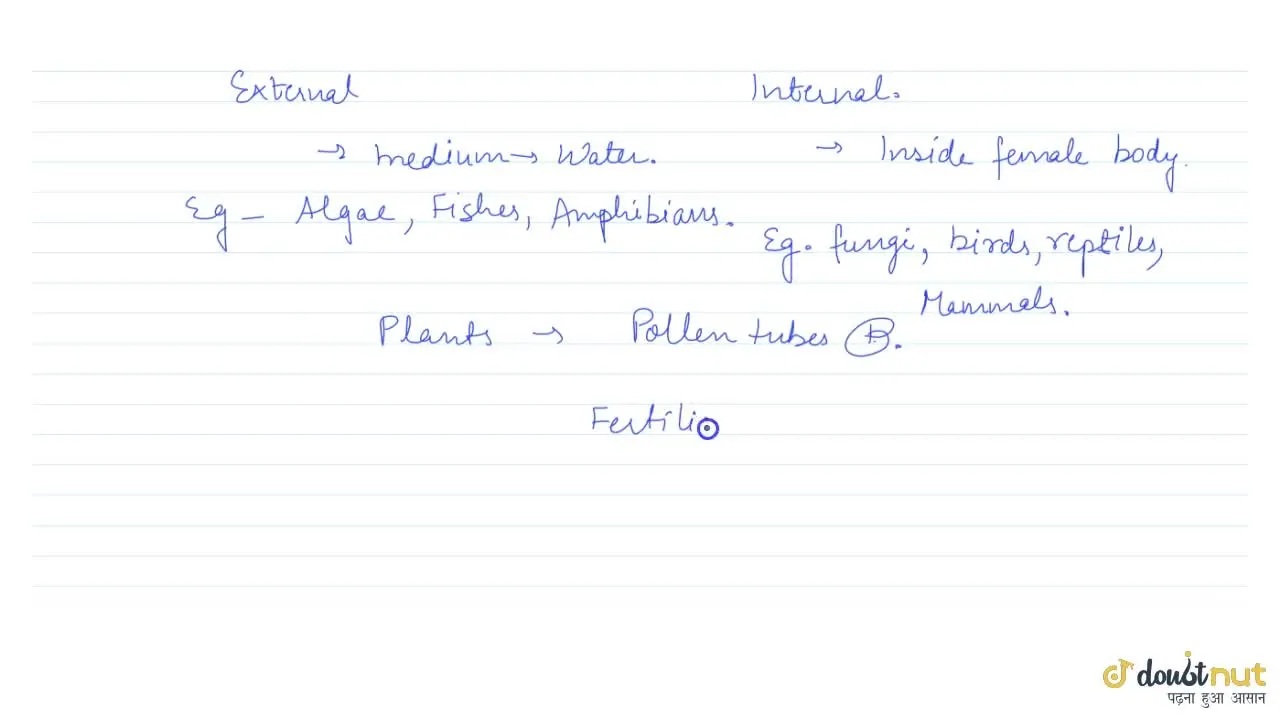Fertilisation
Fertilisation
Fertilisation and implantation are the most basic events in the reproduction process. In this procedure, both egg and sperm fuse together to shape a zygote. Later it gets embedded into the uterus, and an organism develops.
Let us know better how the fertilisation process in humans takes place.
Fertilisation in Humans
Fertilisation is the natural procedure of combination of male and female gametes bringing about the arrangement of a zygote. The fertilisation happens in the fallopian tube.
In this procedure, semen containing a large number of sperms is inseminated into the female vagina during copulation. The sperms move towards the uterus with regards to arriving at the opening of the fallopian tube.
The secondary oocyte discharges from the matured Grafian follicle of the ovary and goes into the fallopian tube, where it is treated inside 24 hours, after which it is released from the ovary.
In spite of the fact that encompassed by a few sperms, the oocyte is prepared by a single sperm. During meiosis-II, the sperm enters the optional oocyte and finishes the meiosis. After this, the auxiliary oocyte is known as the egg.
Both sperm and egg can show their imperativeness just to a constrained period. Sperm stays alive for 48-72 hours in a female regenerative framework, while the egg can be treated for 24 hours before it is discharged.
Steps of Fertilisation in Humans
The Fertilisation procedure in humans happens in different stages, which involved both the substance and physical occasions. The various phases of treatment in humans are referenced beneath:
Acrosomal Reaction
The sperms crippling experience acrosomal responses and discharge certain synthetic substances known as sperm lysins present in the acrosome. Due to the acrosomal responses, the plasma film of the optional oocyte and the sperm combine so the substance of the sperms can enter. At the point when the plasma layer of the sperm attaches with that of the optional oocyte, the plasma film of the oocyte depolarises. This prevents polyspermy. Calcium particles assume a remarkable job in the acrosomal response. The fundamental variables basic for acrosomal responses are ideal pH, temperature and calcium and magnesium focus.
Related Videos:
Cortical Reaction
Soon after the combination of the plasma films, the oocyte shows cortical responses. Cortical granules are found under the plasma film of the oocyte, which connects the plasma layer and discharges cortical proteins between the zona pellucida and plasma layer. The zona pellucida is solidified by the cortical catalysts that forestall polyspermy.
Sperm Entry
The secondary oocyte shapes a projection known as the cone of the gathering at the point of sperm contact. This cone of gathering receives the sperm.
Karyogamy
After the entry of the sperm, the suspended second meiotic division is finished by the auxiliary oocyte. This offers to ascend to a haploid ovum and a second polar body. The leader of the sperm containing the core separates from the whole sperm and is known as male pronucleus. The core of the ovum is known as female pronuclei.
The male and female pronuclei intertwine, and their cell wall degenerate. The combination of the chromosomes of male and female gametes is called karyogamy. The ovum is presently treated and is known as a zygote.
Activation of Eggs
The entry of sperm triggers the digestion in the zygote. Thus, protein union and cell breath increment.
Implantation
When fertilisation occurs, the cell begins to partition and multiply inside 24 hours in the fallopian tube. This isolates multi-celled structure is called a zygote. Afterwards, following 3-4 days it goes to the uterus, and now we call it as an embryo.
The embryo experiences different stages and gets joined to the endometrial layer of the uterus. This procedure of connection is known as implantation.
Sex Determination
Fertilisation is the procedure where another cell is framed when two gametes (sex cells) – sperm and ova intertwine. During this impartial occasion, all genetic data is moved from both the guardians to their kid, and the sex of the kid is resolved.
Father decides the sex of the youngster, for example, if the sperm carries a Y chromosome, the child will be a boy, and if sperm carries X chromosome then the child will be a girl. So, this is the process of sex determination which has been clearly explained in the best way.
Important Chapters:
Similar Questions
Recap|Activity|Fertiliser|Disadvantage Of Fertiliser|What Needs To Be Done|Difference Between Fertiliser And Manure|Advantages Of Manure|Irrigation|Methods Of Irrigation|OMR
View SolutionEggs of cockroach are fertilised in
View SolutionFertilisers are the chemicals rich in
View SolutionIn mammals , egg is fertilised in :-
View SolutionComplete fertilisers include
View SolutionIf fertilisers are added to fresh water
View SolutionThe use of fertilisers in farming is an example of
View SolutionName one biodegradable fertiliser.
View SolutionWhat are fertilisers?
View SolutionWhich of the following is not true for fertilisers?
View Solution


